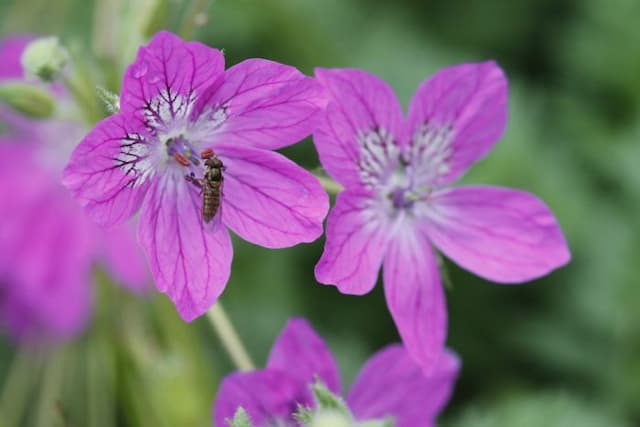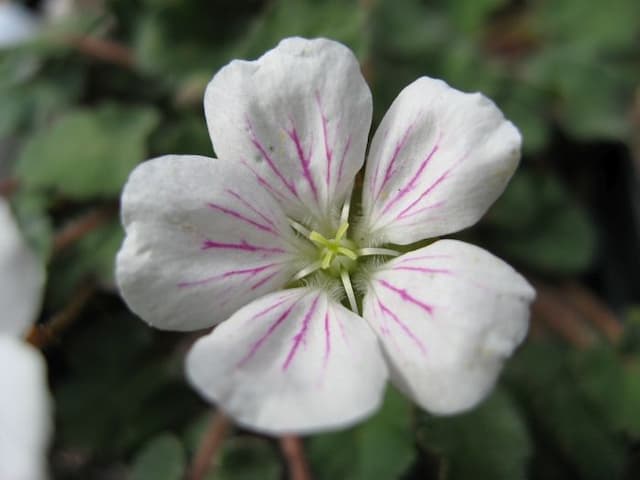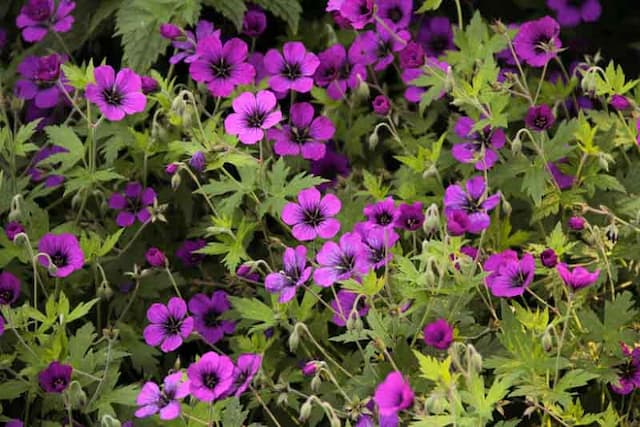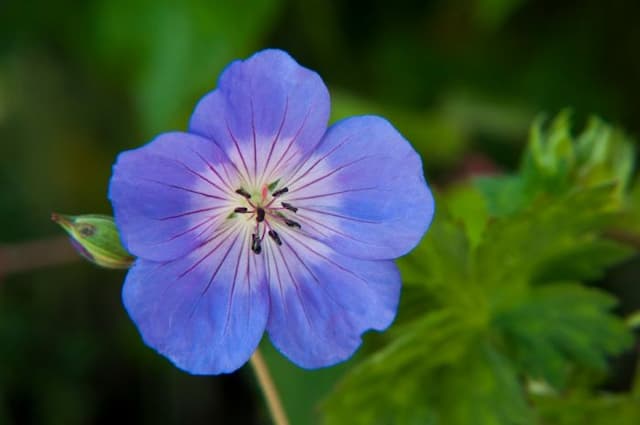Geranium Pelargonium 'Apache' (Z/d)

ABOUT
Pelargonium 'Apache' is a type of Geranium characterized by its showy appearance. It boasts a vibrant display of flowers that are typically a vivid shade of red or deep pink. These flowers have a rounded shape and are made up of five petals, often with darker coloration or veining at their bases, which adds to their visual appeal. The flowers are clustered together in what are known as inflorescences, creating a bold splash of color that can be very eye-catching. The foliage of Pelargonium 'Apache' is equally attractive, composed of leaves that are somewhat rounded with scalloped or lobed edges. The leaves possess a soft, velvety texture with a rich green color that can have a zonal pattern. This refers to a darker colored zone or band that can be seen on the leaves, adding contrast and interest. Pelargonium 'Apache' plants have a bushy habit, forming a dense and lush mound of both flowers and foliage. This dense growth offers a full-bodied appearance that makes it an ideal plant for adding texture to gardens or for use in containers where its attractive features can be prominently displayed. The combination of its striking flowers and patterned leaves creates a plant that is both visually appealing and a favorite among gardenistas for its ornamental value.
About this plant
 Names
NamesSynonyms
Apache Geranium
Common names
Pelargonium 'Apache'.
 Toxicity
ToxicityTo humans
Geraniums, including the Pelargonium 'Apache', are generally not considered toxic to humans. However, they can cause minor skin irritation in sensitive individuals. If ingested, they may cause mild gastrointestinal upset, such as vomiting or diarrhea.
To pets
Geraniums, specifically Pelargonium 'Apache', are known to be toxic to pets, especially cats and dogs. If ingested, they can cause symptoms such as drooling, vomiting, diarrhea, lethargy, and nose and mouth irritation. In severe cases, ingestion can lead to more serious symptoms, including dermatitis, anorexia, depression, and even kidney failure in rare cases.
 Characteristics
CharacteristicsLife cycle
Perennials
Foliage type
Evergreen
Color of leaves
Green
Flower color
Red
Height
1-2 feet (30-60 cm)
Spread
1-2 feet (30-60 cm)
Plant type
Herb
Hardiness zones
10
Native area
South Africa
Benefits
 General Benefits
General Benefits- Easy to grow: Pelargonium 'Apache' is known for being low maintenance and easy to cultivate in a variety of environments.
- Versatile plant: Can be grown both indoors and outdoors, in containers or garden beds, making it suitable for different types of gardeners and spaces.
- Attractive foliage: Offers decorative leaves that can add a touch of greenery to any setting.
- Long blooming period: Produces vibrant flowers that can bloom for an extended period, often from spring to fall.
- Drought-tolerant: Once established, it requires minimal watering, making it suitable for xeriscaping and water-wise gardens.
- Enhances garden aesthetics: Its colorful blossoms can enhance the visual appeal of garden arrangements and landscape designs.
- Attracts pollinators: Flowers can attract beneficial insects like bees and butterflies, contributing to pollination in the garden.
 Medical Properties
Medical PropertiesThis plant is not used for medical purposes.
 Air-purifying Qualities
Air-purifying QualitiesThis plant is not specifically known for air purifying qualities.
 Other Uses
Other Uses- Crafts: The leaves and flowers of the geranium can be pressed and used in dried flower arrangements or for decorative elements in crafting, like in scrapbooking or making homemade paper.
- Herbal Baths: Fresh or dried geranium petals can be added to bathwater for a fragrant and relaxing experience.
- Aromatherapy: The essential oil from geranium plants, though not specific to Pelargonium 'Apache', is often used in aromatherapy for its potential to help reduce stress and anxiety.
- Culinary Garnish: Edible varieties of geraniums can be used as a colorful garnish on desserts or in cocktails for a subtle floral note.
- Fragrance Sachets: Dried geranium leaves can be placed in small sachets to freshen up clothes in drawers and wardrobes.
- Botanical Prints: The distinctive shapes of geranium leaves and flowers can be used to make botanical prints on fabric or paper.
- Natural Dye: Geranium petals can be used to create a natural dye for textiles, resulting in a range of colors based on the mordant used.
- Insect Repellent: Some geraniums are believed to have insect-repelling properties which can be utilized by placing cut leaves around outdoor seating areas.
- Companion Planting: Geraniums are sometimes used in the garden to help repel certain pests, acting as a companion plant to vegetables and other flowers.
- Teaching and Education: Geraniums can serve as an example in botanical and horticultural education, illustrating plant propagation techniques like stem cutting.
Interesting Facts
 Feng Shui
Feng ShuiThe Geranium is not used in Feng Shui practice.
 Zodiac Sign Compitability
Zodiac Sign CompitabilityThe Geranium is not used in astrology practice.
 Plant Symbolism
Plant Symbolism- Transformation: The Pelargonium 'Apache', commonly known as Geranium 'Apache', often symbolizes transformation due to its ability to adapt and thrive in various conditions, reflecting personal growth and change.
- Balance: The Geranium 'Apache' can represent balance and harmony, perhaps because of its symmetric flower structure and ability to balance its needs for sunlight and moisture.
- Friendship: Geraniums, in general, are associated with friendship and positive social interactions, with the 'Apache' variety continuing this tradition as a gift between friends.
- Health and Healing: With geraniums often found in healing gardens, the 'Apache' is no exception, representing health, recovery, and the healing process.
 Water
WaterGeraniums, like the Pelargonium 'Apache', should be watered thoroughly when the soil feels dry to the touch. During active growing months, this often means watering once every 1-2 weeks, but always check the soil's moisture level first. Allow the water to soak in until it runs out of the drainage holes, ensuring you're not just wetting the surface. Depending on the pot size and the environmental conditions, this might equate to approximately 16-32 ounces of water each time for a standard indoor pot. Reduce watering in the winter months when growth slows down.
 Light
LightThe Pelargonium 'Apache', commonly known as geranium, thrives best in bright, indirect sunlight. A spot near a south or west-facing window that receives at least 6 hours of daylight is ideal, but direct afternoon sun should be avoided to prevent leaf scorch. These plants can also tolerate partial shade, but flowering may be reduced in lower light conditions.
 Temperature
TemperatureGeraniums, including Pelargonium 'Apache', favor temperatures between 65 and 75 degrees Fahrenheit during the day and should not drop below 50 degrees Fahrenheit at night. They can survive brief periods down to 30 degrees Fahrenheit, but frost can be damaging. To promote continuous growth, keep your geranium in a consistently warm spot away from drafts and sudden temperature changes.
 Pruning
PruningPruning your Pelargonium 'Apache', or geranium, is essential for encouraging bushy growth and removing dead or yellowing leaves and spent flowers, which helps prevent disease. Prune lightly throughout the growing season to shape the plant and promote more blooms. The best time for major pruning is early spring, just as new growth appears, as this gives the plant time to recover and bloom in the upcoming season.
 Cleaning
CleaningAs needed
 Soil
SoilGeranium 'Apache' thrives in a well-draining potting mix with equal parts of peat, pine bark, and perlite or coarse sand. The ideal soil pH for this geranium should be slightly acidic to neutral, around pH 6.0-7.0.
 Repotting
RepottingGeranium 'Apache' should generally be repotted once every two to three years or when it has outgrown its current container. It's best to repot in spring before the new growth starts.
 Humidity & Misting
Humidity & MistingGeranium 'Apache' prefers moderate humidity levels but is quite adaptable. Aim for a humidity level between 40% and 60% for optimal growth.
 Suitable locations
Suitable locationsIndoor
Place in bright, indirect light and keep away from drafts.
Outdoor
Plant in full sun to partial shade; protect from strong winds.
Hardiness zone
9-11 USDA
 Life cycle
Life cycleThe life of Pelargonium 'Apache' (often known as Geranium 'Apache') begins with the germination of seeds or rooting of cuttings, typically in a warm and moist environment to promote growth. Seedlings or young plants are then transplanted into individual pots or garden beds where they establish a root system and develop leaves. During its vegetative stage, it focuses on leaf growth and strengthening its stems, requiring proper watering and exposure to bright, indirect light. The Geranium 'Apache' then enters the flowering stage, producing clusters of vividly colored blooms, often in shades of red or pink, which attract pollinators and last for several weeks. Once pollinated, the plant sets seeds, completing its reproductive cycle, though many gardeners remove spent flowers to encourage further blooming and maintain the plant's visual appeal. As a perennial in warmer climates, it may enter a dormant phase in response to cooler temperatures, reducing growth or dying back, to then regrow from its root system with the return of favorable conditions.
 Propogation
PropogationPropogation time
Spring-Early Summer
The popular method to propagate Pelargonium 'Apache', commonly known as Geranium ‘Apache’, is through stem cuttings. This is typically done in late winter or early spring before the onset of the growing season. Healthy, non-flowering shoots are selected to make cuttings of about 4-6 inches (10 to 15 cm) in length. The lower leaves are removed, and the cut end of the stem is often dipped in rooting hormone powder to encourage root development. The cutting is then inserted into a potting mix that is lightweight and well-draining. It is important to maintain a moist environment for the cutting, but not overly wet, as this may cause rot. The pot containing the cutting should be kept in a warm place with indirect light until roots have developed, which usually takes a few weeks. Once rooted, the new plants can be transplanted into individual pots or outdoor beds.








![Cranesbill [Rothbury Gem]](/_next/image?url=https%3A%2F%2Fplants-admin.emdemapps.com%2Fimages%2Fplants%2F%2Fimages%2F604b6243984c2.png&w=640&q=75)
